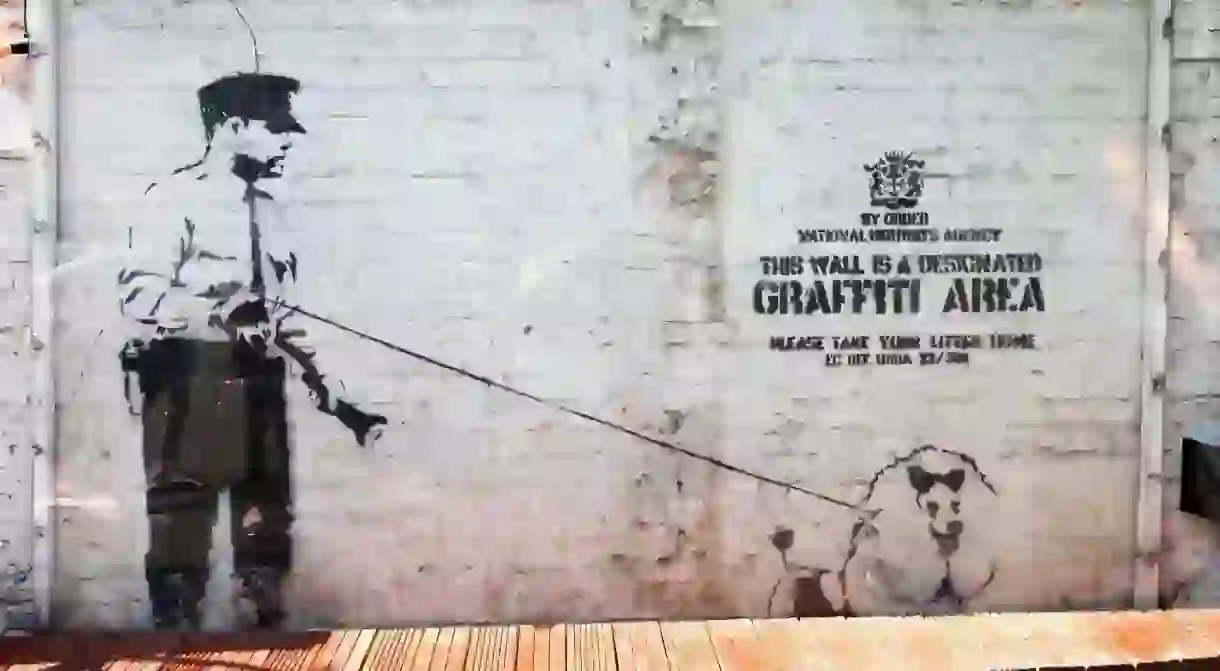The Best Streets in Shoreditch, London, to See Graffiti

Cool, creative and with a twist of grit, Shoreditch is one of London’s hippest neighbourhoods. It’s also an urban exhibition of street art, featuring pieces from some of the biggest names – yes, Banksy has left his mark here – and up-and-coming talents. So grab a flat white, hit the streets – and tick these locations off your graffiti hit list.
Rivington Street
Building, Art Gallery
Running like a narrow artery of coffee shops, delis and clothes boutiques, Rivington Street is one of Shoreditch’s hippest streets. It was also the location of one of Banksy’s earliest works, stencilled along the wall beneath the railway bridge near Shoreditch High Street. This has become a key site for aspiring street artists, and new works appear regularly. Located in the yard of the Cargo Club is his Designated Graffiti Area, while a work by the artist Bambi (dubbed the female Banksy) sits on the wall opposite.
Great Eastern Street
Building

Cremer Street
Building
Princelet Street
Building

This quiet, mostly residential street of old Victorian workers’ terraced houses might not seem like the obvious place to find a work by one of London’s biggest street artists. But perhaps that’s why Stik picked it. You’ll find his creation, which celebrates London’s cultural diversity (and perhaps the Brick Lane Mosque round the corner), with two stick figures, one wearing a burka, sprayed onto the red shutter doors of No26.
Toynbee Street
Building
Unassuming Toynbee Street, which runs parallel to Commercial Street, has rolled out some standout pieces of street art over the years. A recent large commercial development has knocked out a few of the best-known ones but there are still some interesting pieces to spot, including the 3D image of two octopuses sharing an ice lolly, and an abandoned building painted all white, with a yellow rhombus painted across the front.
Shoreditch High Street
Building
Running between Shoreditch Church and the junction with Commercial and Great Eastern Street, Shoreditch High Street is a busy parade of shops, restaurants and bars, dotted with street artworks. Look out for the slightly spooky 3D face moulds by Gregos Art, which can be found emerging from walls like Han Solo’s carbonite frieze, in different sizes at various locations around the area.
Heneage Street
Building

Quiet, cobbled and under-the-radar Heneage Street, just off Brick Lane, presides over a surprisingly stellar line-up of artists. Near the Brick Lane end, you’ll have to stoop to spot the three delicately sprayed characters of Lewis Campbell’s Hear No Evil, Speak No Evil and See No Evil, while just a door or two down, Barcelona-based artist Malark has covered a shop shutter in one his signature surreal, cartoonish pieces. Down at the other end, a vast mural by artist Phlegm is a collector’s item.
Fashion Street
Building
Branching off Brick Lane, Fashion Street might not boast the big names (at the time of writing, at least), but it makes up for it in the number and diversity of up-and-coming artists showing off their work, from a Batman animation and a curious poster of Arnold Schwarzenegger to a bright-purple animation of a feminine face and more. There’s also a huge mural of a man embracing a child created by dripping paint, yours to admire on the side of Joe’s Kid Café.
Brick Lane
Building

Famous for its curry houses, nightclubs and second-hand clothes shops, Brick Lane has been a hotspot for emerging street artists for decades. From building-site hoardings to brick walls and shop shutters, if there’s a free square metre of space, it’s a canvas. Don’t forget either to dive down its alleyways and nose around in the little squares that shoot off of it — that’s where you’ll normally find work by the bigger names: Banksy, Fanakapan, and Mr Cenz.
Bell Lane & Goulston Street
Building
Make your way to the south end of Bell Lane and little Goulston Street after the stores have shut for the day and you’ll be flanked on both sides by an exhibition of painted shop shutters. With practically every single one completely covered in either a painstakingly embellished tag, an abstract piece of design or something more stylised — the shady portrait of a young boy by Australian painter and street artist Guido Van Helten, perhaps — it’s a feast for the eyes.
This is an updated version of an article originally by Angie Quinn.













